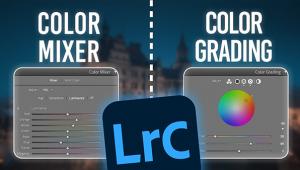Konica Minolta Maxxum 7D
First D-SLR Camera With Built-In Anti-Shake System Page 2
Image Quality Issues
The Maxxum 7D offers three JPEG size and quality options plus raw capture for
recording data from the CCD sensor. In both raw and JPEG Large/Extra Fine mode,
image quality is superlative: suitable for making gorgeous 11x17" prints
or very good 13x19" glossies. Because compression is minimal, there's
no evidence of JPEG artifacts or jagged edges even at 200 percent magnification
on a monitor. A higher compression ratio is used in JPEG Fine mode, but image
quality is still very good at 100 percent magnification.
 |
 |
|
|
||
Digital noise is exceptionally well controlled making ISO 400 suitable for
all-purpose use in serious photography. The camera is great for low-light shooting
as well, because ISO 800 images are surprisingly clean and richly detailed.
By ISO 1600, colored specks are visible in some areas at high magnification,
as with every camera; still, the Large/Extra Fine JPEGs make for highly satisfactory
8.5x11" prints. An ISO 3200 option is available, too, but must be selected
as a custom function; it's not recommended for routine use because digital
noise obliterates fine detail. I resorted to the ultrahigh ISO only when absolutely
necessary: for action-stopping shutter speeds during equestrian action in the
darkest parts of an indoor arena.
Evaluation: The Maxxum 7D offers a full slate of overrides,
and yet, it often produced pleasing photos at the default settings. Sharpness
is moderate but the images respond well to sharpening with Unsharp Mask or Photoshop
plug-ins designed for that purpose. Color saturation is very high, with particularly
vibrant reds and blues. In my opinion, it's sometimes excessive. In wedding
and portrait photography, I would set the saturation level to -2, or tone down
certain colors in post-processing. Other aspects can also be adjusted in camera:
exposure, white balance, hue, and sharpness. Even so, many advanced photographers
will insist on shooting in Raw Capture mode to take advantage of the processing
features available in converter software, such as the bundled DiMAGE Viewer.
 |
|
PROS
· Exceptional versatility in all respects, including flash with optional
HS(D) Program flash units
· Ease of basic use; many features can be accessed quickly with familiar
analog controls
· Anti-Shake system provides stabilization with most Maxxum lenses
· Quick response, fast framing rate, and great burst depth
· Excellent image quality; digital noise and JPEG artifacts are very well
controlled
CONS
· Too many options in the electronic menu, some not intuitive and not
well explained in the instructions
· Some Anti-Shake system limitations, described in the Anti-Shake sidebar
· DiMAGE Viewer software (for raw file adjustment and conversion) is not
particularly fast or versatile; optional DiMAGE Master software is preferable
· High price in the 6-megapixel category but Anti-Shake system adds substantial
value
 |
|
|
|
|
Technical Specifications
Image Sensor: 23.5x15.7mm CCD with RGB filter array; 6.1 million
recording pixels; 1.5x field of view crop
Anti-Shake: Built-in CCD-Shift system provides stabilization
with most Maxxum lenses
Shutter Speeds: 30 to 1/4000 sec plus Bulb; top flash sync
speed of 1/160 or 1/125 when Anti-Shake is active
Operating Modes: Full Auto Program, Shiftable Program, Aperture
Priority and Shutter Priority AE plus Manual mode
Drive: Single frame and continuous at up to 3 fps advance;
self-timer; interval shooting mode
Autofocus System: Nine-point sensor, with cross-hatched central
sensor; any sensor selectable; single-shot autofocus and continuous predictive
tracking autofocus available; focus-assist beam with pre-flash
Exposure System: Center-weighted, spot, and 14-segment honeycomb
pattern (evaluative) metering; exposure compensation, AE Lock, and AE bracketing
for ambient light or flash
White Balance: Automatic, Daylight, Shade, Cloudy, Tungsten,
Fluorescent, Flash, Custom, Color Temperature also selectable
Image Adjustments: Five (+/-) levels of contrast, color saturation,
hue, and sharpness
Flash: Built-in, with manual control and pre-flash TTL; ADI
metering with D-series lenses; fill flash, flash cancel, redeye reduction, and
rear curtain sync modes; wireless off-camera TTL flash and high-speed sync available
with certain flash units
Other Features: sRGB plus Adobe RGB color space; long-exposure
Noise Reduction available; Exif Print, PRINT Image Matching, and PictBridge
compliant; USB 2.0 High Speed plus Video output; numerous custom functions;
accepts CompactFlash Type I and II cards
Power: One NP-400 lithium ion battery; optional AC adapter;
optional VC-7D Vertical Control Grip accepts NP-400 or Ni-MH AAs
Dimensions/Weight: 5.9x4.2x3.1"; 26.81 oz
s$1599
Anti-Shake System Technology
Previously available in some DiMAGE cameras with built-in lenses, the Anti-Shake
mechanism used in the Maxxum 7D is quite similar. However, the new device is
more robust, designed to match the larger CCD in the digital SLR camera. As
well, it was designed to be effective with a very broad range of lenses, from
ultra-wide to super telephoto, with only two exceptions: the Maxxum 16mm Fisheye
and the 3x-1x Macro Zoom. Quite different in principle than the optical stabilizers
used in some Canon, Nikon, and Sigma lenses, Anti-Shake achieves a comparable
effect: producing sharp images in handheld shooting at longer shutter speeds
than conventional equipment.

The Konica Minolta Anti-Shake system works in the following manner: When the
built-in motion sensor detects camera shake it sends information on the angle
and speed of camera motion to a microcomputer. The latter combines that information
with data on focal length, the current f/stop, and focused distance to make
a sophisticated analysis. Then, it sends a signal to a "Smooth Impact
Drive Mechanism" (SIDM) that mechanically shifts the entire CCD sensor
unit to compensate for a sharper photo with less blurring from camera movement.
A five-step LED indicator in the viewfinder keeps the user informed of the extent
of Anti-Shake activity. The more of the blue LEDs that are illuminated, the
greater the amount of camera shake compensation that is occurring. When all
five are lit, maximum CCD shift is under way. That's a signal that the
system may not be fully compensating for camera shake; switching to a faster
shutter speed will increase the odds of blur-free images.

Regardless of the technology used, no stabilizer system is perfect, because
it cannot compensate for subject movement; only a fast shutter speed can "freeze"
motion. Also note the following comment in the Maxxum 7D Owners Manual:
"Anti-Shake is less effective with moving subjects or when the camera
is panned, at shutter speeds of 1/4 sec or longer and at short object distances
[as in macro photography]." Konica Minolta also recommends turning the
Anti-Shake system off when the camera is mounted on a tripod. That's not
a drawback because there's no need for shake compensation when using a
firm support.
Final Assessment
The Maxxum 7D costs more than most 6-megapixel cameras, probably because of
the Anti-Shake mechanism that provides stabilization with numerous types of
lenses. Although it would be the most logical choice for anyone who already
owns Maxxum lenses, this digital SLR should appeal to any advanced photo enthusiast
because of its unusually rich feature set. Add an optional 5600HS(D) flash unit,
and the combination becomes highly desirable for most every type of serious
photography.
For more information about the Maxxum 7D, visit Konica Minolta's website
at: http://konicaminolta.us.
A long-time "Shutterbug" and "eDigitalPhoto" contributor, stock photographer Peter K. Burian is the author of two recent books: "Magic Lantern Guide to the Konica Minolta Maxxum 7D" (Lark Books) and "Mastering Digital Photography and Imaging" (Sybex).
- Log in or register to post comments



































